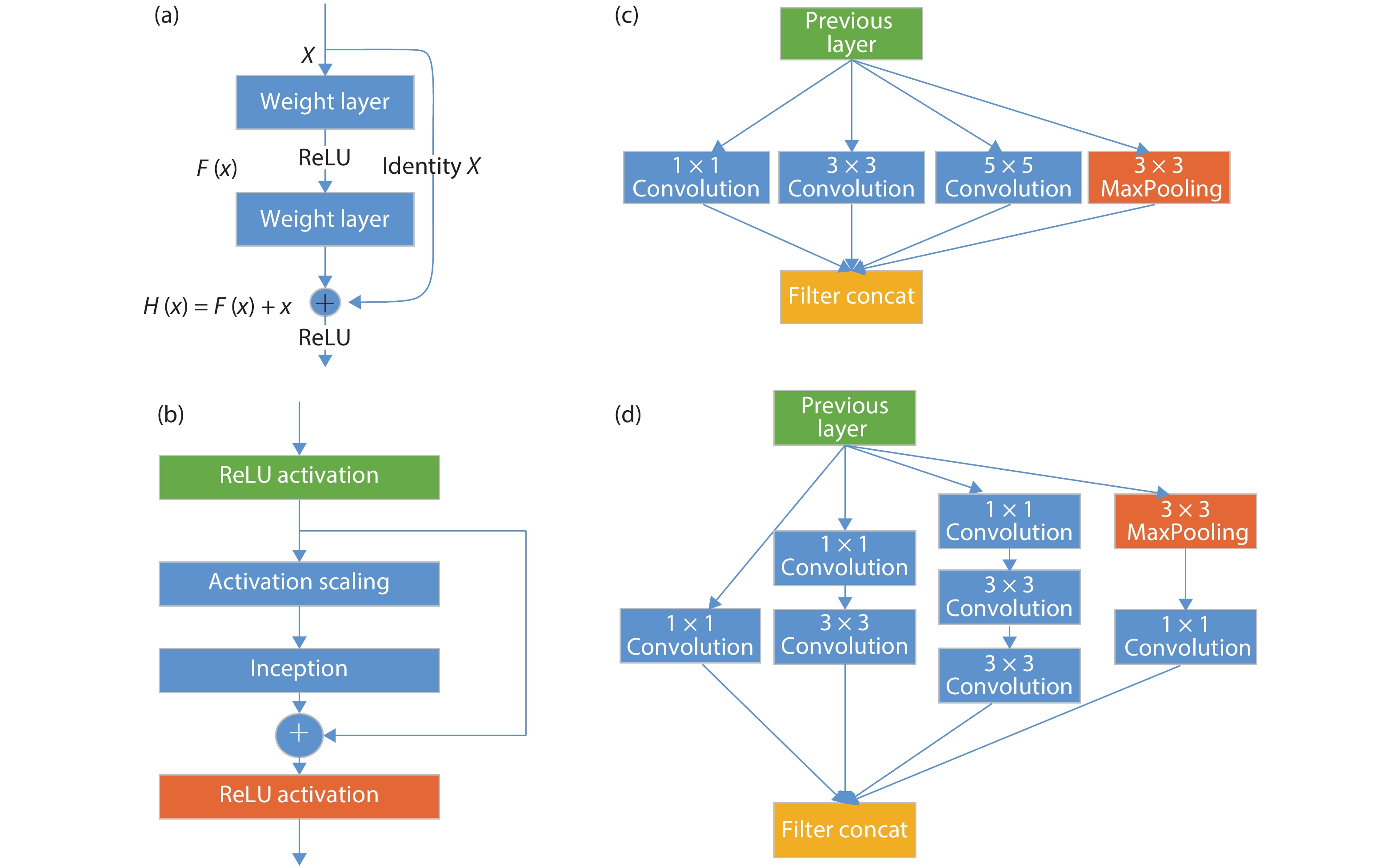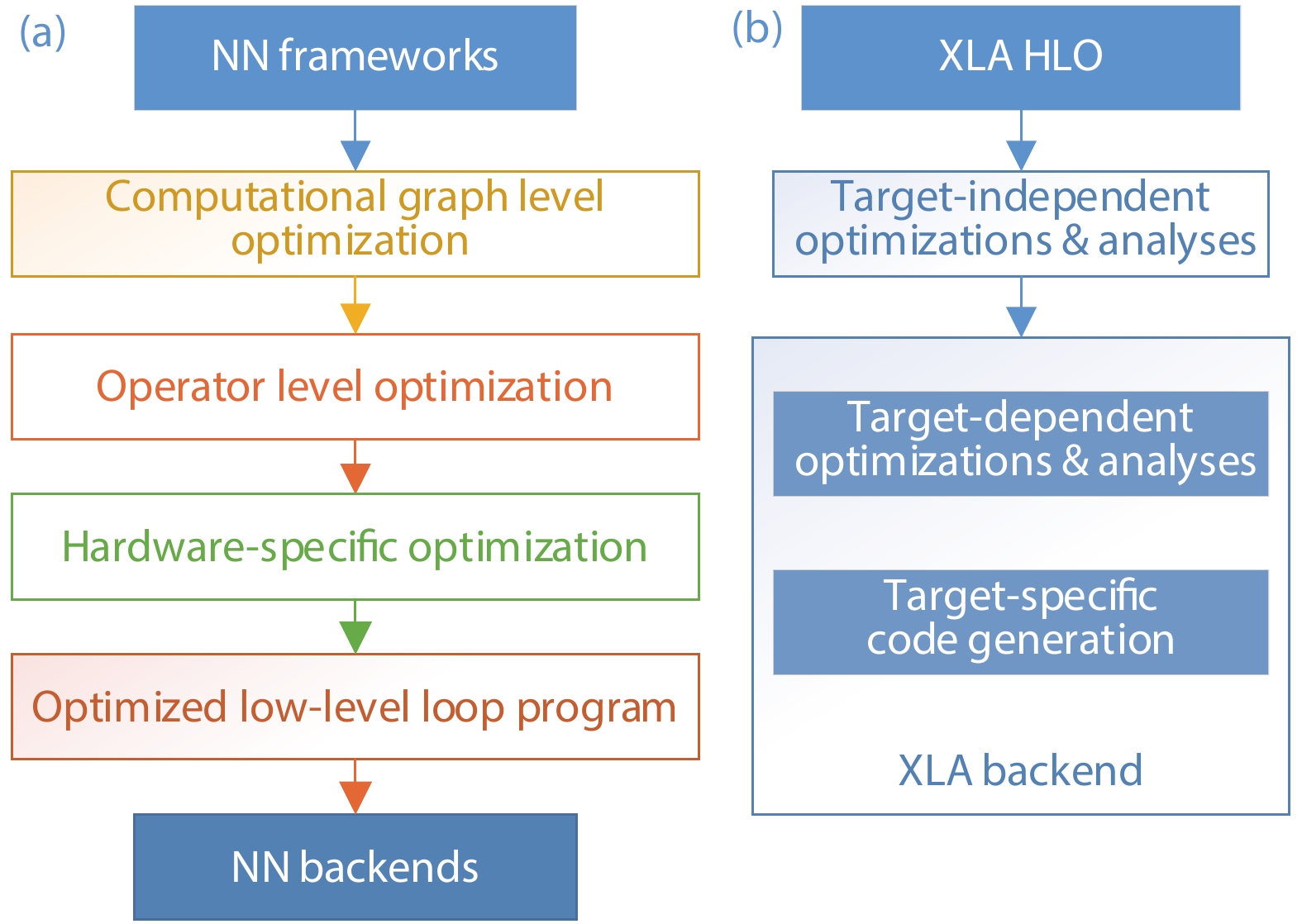| Citation: |
Jin Song, Xuemeng Wang, Zhipeng Zhao, Wei Li, Tian Zhi. A survey of neural network accelerator with software development environments[J]. Journal of Semiconductors, 2020, 41(2): 021403. doi: 10.1088/1674-4926/41/2/021403
****
J Song, X M Wang, Z P Zhao, W Li, T Zhi, A survey of neural network accelerator with software development environments[J]. J. Semicond., 2020, 41(2): 021403. doi: 10.1088/1674-4926/41/2/021403.
|
A survey of neural network accelerator with software development environments
DOI: 10.1088/1674-4926/41/2/021403
More Information
-
Abstract
Recent years, the deep learning algorithm has been widely deployed from cloud servers to terminal units. And researchers proposed various neural network accelerators and software development environments. In this article, we have reviewed the representative neural network accelerators. As an entirety, the corresponding software stack must consider the hardware architecture of the specific accelerator to enhance the end-to-end performance. And we summarize the programming environments of neural network accelerators and optimizations in software stack. Finally, we comment the future trend of neural network accelerator and programming environments. -
References
[1] Huang W, Jing Z. Multi-focus image fusion using pulse coupled neural network. Pattern Recogn Lett, 2007, 28(9), 1123 doi: 10.1016/j.patrec.2007.01.013[2] Paik J K, Katsaggelos A K. Image restoration using a modified hopfield network. IEEE Trans Image Process, 1992, 1(1), 49 doi: 10.1109/83.128030[3] Li X, Zhao L, Wei L, et al. DeepSaliency: multi-task deep neural network model for salient object detection. IEEE Trans Image Process, 2016, 25, 3919 doi: 10.1109/TIP.2016.2579306[4] Zhu Y, Urtasun R, Salakhutdinov R, et al. segDeepM: exploiting segmentation and context in deep neural networks for object detection. Proceedings of the IEEE Conference on Computer Vision and Pattern Recognition, 2015, 4703[5] Graves A, Mohamed A R, Hinton G. Speech recognition with deep recurrent neural networks. 2013 IEEE International Conference on Acoustics, Speech and Signal Processing, 2013, 6645[6] Abdelhamid O, Mohamed A, Jiang H, et al. Convolutional neural networks for speech recognition. IEEE/ACM Trans Audio Speech Language Process, 2014, 22(10), 1533 doi: 10.1109/TASLP.2014.2339736[7] Collobert R, Weston J. A unified architecture for natural language processing. International Conference on Machine Learning, 2008[8] Sarikaya R, Hinton G E, Deoras A. Application of deep belief networks for natural language understanding. IEEE/ACM Trans Audio, Speech, Language Process, 2014, 22(4), 778 doi: 10.1109/TASLP.2014.2303296[9] Simonyan K, Zisserman A. Very deep convolutional networks for large-scale image recognition. arXiv preprint arXiv: 1409.1556, 2014[10] McCulloch W S, Pitts W. A logical calculus of ideas immanent in nervous activity. Bull Math Biophys, 1943, 5(4), 115 doi: 10.1007/BF02478259[11] Rosenblatt F. The perceptron: a probabilistic model for information storage and organization in the brain. Psycholog Rev, 1958, 65(6), 386 doi: 10.1037/h0042519[12] Werbos P. Beyond regression: new tools for prediction and analysis in the behavioral sciences. Dissertation for the Doctoral Degree, Harvard University, 1974[13] Hinton G E, Osindero S, Teh Y. A fast learning algorithm for deep belief nets. Neur Comput, 2006, 18(7), 1527 doi: 10.1162/neco.2006.18.7.1527[14] Krizhevsky A, Sutskever I, Hinton G E. ImageNet classification with deep convolu-tional neural networks. Advances in Neural Information Processing Systems, 2012, 1097[15] He K, Zhang X, Ren S, et al. Deep residual learning for image recognition. Proceedings of the IEEE Conference on Computer Vision and Pattern Recognition, 2016, 770[16] Szegedy C, Liu W, Jia Y, et al. Going deeper with convolutions. Proceedings of the IEEE Conference on Computer Vision and Pattern Recognition, 2015, 1[17] Szegedy C, Ioffe S, Vanhoucke V, et al. Inception-v4, Inception-ResNet and the impact of residual connections on learning. National Conference on Artificial Intelligence, 2016, 4278[18] Yu F, Koltun V. Multi-scale context aggregation by dilated convolutions. arXiv: 1511.07122, 2015[19] Mamalet F, Garcia C. Simplifying convnets for fast learning. international conference on artificial neural networks. International Conference on Artificial Neural Networks, 2012, 58[20] Howard A G, Zhu M, Chen B, et al. MobileNets: efficient convolutional neural networks for mobile vision applications. arXiv: 1704.04861, 2017[21] Cho K, Van Merrienboer B, Gulcehre C, et al. Learning phrase representations using RNN encoder-decoder for statistical machine translation. arXiv preprint arXiv: 1406.1078, 2014[22] Hochreiter S, Schmidhuber J. Long short-term memory. Neur Comput, 1997, 9(8), 1735 doi: 10.1162/neco.1997.9.8.1735[23] Vaswani A, Shazeer N, Parmar N, et al. Attention is all you need. Advances in Neural Information Processing Systems, 2017, 5998[24] Devlin J, Chang M W, Lee K, et al. BERT: pre-training of deep bidirectional transformers for language understanding. arXiv preprint arXiv: 1810.04805, 2018[25] Parashar A, Rhu M, Mukkara A, et al. SCNN: An accelerator for compressed-sparse convolutional neural networks. 2017 ACM/IEEE 44th Annual International Symposium on Computer Architecture (ISCA), 2017[26] Han S, Mao H, Dally W J. Deep compression: compressing deep neural networks with pruning, trained quantization and huffman coding. arXiv preprint arXiv: 1510.00149, 2015[27] Lin D D, Talathi S S, Annapureddy V S. Fixed point quantization of deep convolutional networks. International Conference on Machine Learning, 2016, 2849[28] Xue J, Li J, Yu D, et al. Singular value decomposition based low-footprint speaker adaptation and personalization for deep neural network. IEEE International Conference on Acoustics, 2014[29] Park E, Ahn J, Yoo S. Weighted-entropy-based quantization for deep neural networks. IEEE Conference on Computer Vision & Pattern Recognition, 2017[30] Song L, Wang Y, Han Y, et al. C-Brain: A deep learning accelerator that tames the diversity of CNNs through adaptive data-level parallelization. Design Automation Conference, 2016[31] Kuo R J, An Y L, Wang H S, et al. Integration of self-organizing feature maps neural network and genetic K-means algorithm for market segmentation. Expert Syst Appl, 2006, 30(2), 313 doi: 10.1016/j.eswa.2005.07.036[32] Roska T, Bártfai G, Szolgay P, et al. A digital multiprocessor hardware accelerator board for cellular neural networks: CNN-HAC. Int J Circuit Theory Appl, 1992, 20(5), 589 doi: 10.1002/cta.4490200512[33] Gokhale V, Zaidy A, Chang A X M, et al. Snowflake: a model agnostic accelerator for deep convolutional neural networks. arXiv preprint arXiv: 1708.02579, 2017[34] Page A, Jafari A, Shea C, et al. SPARCNet: a hardware accelerator for efficient deployment of sparse convolutional networks. ACM J Emerg Technolog Comput Syst, 2017, 13(3), 1[35] Chen T, Chen Y, Duranton M, et al. BenchNN: On the broad potential application scope of hardware neural network accelerators. 2012 IEEE International Symposium on Workload Characterization (IISWC), 2012, 36[36] Farabet C, Poulet C, Han J Y, et al. CNP: An FPGA-based processor for convolutional networks. International Conference on Field Programmable Logic and Applications, 2009[37] Zhang S, Du Z, Zhang L, et al. Cambricon-X: An accelerator for sparse neural networks. The 49th Annual IEEE/ACM International Symposium on Microarchitecture, 2016, 20[38] Yu Y, Zhi T, Zhou X, et al. BSHIFT: a low cost deep neural networks accelerator. Int J Paral Program, 2019, 47, 360 doi: 10.1007/s10766-018-00624-9[39] Shafiee A, Nag A, Muralimanohar N, et al. ISAAC: a convolutional neural network accelerator with in-situ analog arithmetic in crossbars. 2016 ACM/IEEE 43rd Annual International Symposium on Computer Architecture (ISCA), 2016[40] Chen Y H, Krishna T, Emer J S, et al. Eyeriss: an energy-efficient reconfigurable accelerator for deep convolutional neural networks. IEEE J Solid-State Circuits, 2017, 52(1), 127 doi: 10.1109/JSSC.2016.2616357[41] Jouppi N P, Young C, Patil N, et al. In-datacenter performance analysis of a tensor processing unit. 2017 ACM/IEEE 44th Annual International Symposium on Computer Architecture (ISCA), 2017, 1[42] Chen Y, Chen T, Xu Z, et al. DianNao family: energy-efficient hardware accelerators for machine learning. Commun ACM, 2016, 59(11), 105 doi: 10.1145/2996864[43] Chen T, Du Z, Sun N, et al. DianNao: a small-footprint high-throughput accelerator for ubiquitous machine-learning. Proceedings of the 19th International Conference on Architectural Support for Programming Languages and Operating Systems, 2014[44] Chen Y, Luo T, Liu S, et al. Dadiannao: A machine-learning supercomputer. Proceedings of the 47th Annual IEEE/ACM International Symposium on Microarchitecture, 2014, 609[45] Du Z, Fasthuber R, Chen T, et al. ShiDianNao:shifting vision processing closer to the sensor. ACM/IEEE International Symposium on Computer Architecture, 2015[46] Liu D, Chen T, Liu S, et al. Pudiannao: A polyvalent machine learning accelerator. ACM SIGARCH Comput Architect News, 2015, 43(1), 369 doi: 10.1145/2786763.2694358[47] Du Z, Palem K, Lingamneni A, et al. Leveraging the error resilience of machine-learning applications for designing highly energy efficient accelerators. 2014 19th Asia and South Pacific Design Automation Conference (ASP-DAC), 2014, 201[48] Estrin G. Organization of computer systems: the fixed plus variable structure computer. Western Joint IRE-AIEE-ACM Computer Conference, 1960, 33[49] Dehon A, Wawrzynek J. Reconfigurable computing: what, why, and implications for design automation. Proceedings 1999 Design Automation Conferenc, 1999[50] Majumdar A, Cadambi S, Becchi M, et al. A massively parallel, energy efficient programmable accelerator for learning and classification. ACM Trans Architect Code Optim, 2012, 9(1), 1[51] Ansari A, Gunnam K, Ogunfunmi T, et al. An efficient reconfigurable hardware accelerator for convolutional neural networks. 2017 51st Asilomar Conference on Signals, Systems, and Computers, 2017, 1337[52] Ando K, Ueyoshi K, Orimo K, et al. BRein memory: a single-chip binary/ternary reconfigurable in-memory deep neural network accelerator achieving 1.4 TOPS at 0.6 W. IEEE J Solid-State Circuits, 2017, 53(4), 983 doi: 10.1109/JSSC.2017.2778702[53] Lee J, Kim C, Kang S H, et al. UNPU: A 50.6TOPS/W unified deep neural network accelerator with 1b-to-16b fully-variable weight bit-precision. International Solid-State Circuits Conference, 2018, 218[54] You W, Wu C. A reconfigurable accelerator for sparse convolutional neural networks. Proceedings of the 2019 ACM/SIGDA International Symposium on Field-Programmable Gate Arrays, 2019, 119[55] Liu S, Du Z, Tao J, et al. Cambricon: An instruction set architecture for neural networks. ACM SIGARCH Comput Architect News, 2016, 44(3), 393 doi: 10.1145/3007787.3001179[56] Zhao Y, Du Z, Guo Q, et al. Cambricon-F: machine learning computers with fractal von neumann architecture. International Symposium on Computer Architecture, 2019, 788[57] Abadi M, Barham P, Chen J, et al. Tensorflow: A system for large-scale machine learning. 12th USENIX Symposium on Operating Systems Design and Implementation (OSDI 16), 2016, 265[58] Jia Y, Shelhamer E, Donahue J, et al. Caffe: Convolutional architecture for fast feature embedding. Proceedings of the 22nd ACM International Conference on Multimedia, 2014, 675[59] Chen T, Li M, Li Y, et al. MXNet: a flexible and efficient machine learning library for heterogeneous distributed systems. arXiv: 1512.01274, 2015[60] Truong L, Barik R, Totoni E, et al. Latte: a language, compiler, and runtime for elegant and efficient deep neural networks. ACM SIGPLAN Notices, 2016, 51, 209[61] Lan H, Du Z. DLIR: an intermediate representation for deep learning processors. IFIP International Conference on Network and Parallel Computing, 2018, 169[62] Du W, Wu L, Chen X, et al. ZhuQue: a neural network programming model based on labeled data layout. International Symposium on Advanced Parallel Processing Technologies, 2019, 27[63] Fischer K, Saba E. Automatic full compilation of Julia programs and ML models to cloud TPUs. arXiv: 1810.09868, 2018[64] Chen T, Moreau T, Jiang Z, et al. TVM: an automated end-to-end optimizing compiler for deep learning. 13th USENIX Symposium on Operating Systems Design and Implementation, 2018, 578[65] Mendis C, Bosboom J, Wu K, et al. Helium: lifting high-performance stencil kernels from stripped ×86 binaries to halide DSL code. Program Language Des Implem, 2015, 50(6), 391[66] Song J, Zhuang Y, Chen X, et al. Compiling optimization for neural network accelerators. International Symposium on Advanced Parallel Processing Technologies, 2019, 15 -
Proportional views






 DownLoad:
DownLoad:
















